page 16
Note: the contents of this page as well as those which precede and follow, must be read as a continuation and/or overlap in order that the continuity about a relationship to/with the dichotomous arrangement of the idea that one could possibly talk seriously about peace from a different perspective as well as the typical dichotomous assignment of Artificial Intelligence (such as the usage of zeros and ones used in computer programming) ... will not be lost (such as war being frequently used to describe an absence of peace and vice-versa). However, if your mind is prone to being distracted by timed or untimed commercialization (such as that seen in various types of American-based television, radio, news media and magazine publishing... not to mention the average classroom which carries over into the everyday workplace), you may be unable to sustain prolonged exposures to divergent ideas about a singular topic without becoming confused, unless the information is provided in a very simplistic manner.
Let's face it, humanity has a lousy definition, accompanying practice, and analysis of peace.
As an often presented dichotomy (Peace/War[conflict]), we must acknowledge that there exists a superficial desire for peace coupled with a superficial practice of war. In other words, the world is subjected to an illusion. Since Peace is not defined, practiced nor analyzed in any actual serious way, it is clear humanity does not sincerely wish to practice peace except as an illusion... just as it does not actually practice Democracy— except in one or another illusory form. And though some may claim that military action resulting in death and destruction can in no way be interpreted as a superficial expression, it must be noted that the circumstances under which presumed wars, police actions, skirmishes, battles and the like— are for the most part, contrivances which conceal ulterior motives that typically involve some pecuniary, position or power interest. As such, we must ask whether all wars/conflicts are "natural", natural contrivances, or merely contrivances as an exercise of artificiality... like a tinkerer in chemicals, electricity, drafting, constructing, experimentation, etc...
Far too many conflicts resulting in social disharmony are the result of deliberate instigations that sometimes effect little more than a philosophy of "stirring the pot" "to see what happens"... like a child interrupting the industry of ants with a stick or some other intrusive mechanism. Those wishing to promote a personal agenda by way of perpetrating a conflict instead of seeking resolution in the face of a potential conflict that they wish to escalate in order to carry out some role playing exercise; very often use such words as "terrorism", "attack", "war"... and the like, to instigate reactions from like-minded others whose living standards have learned to gain by exploiting fear, uncertainty, and apprehension in the public or amongst other nations leaders. But such remarks are ideas which are widely understood as a reality, yet have been excluded from any attempted analysis of peace from various subject headings other than a predominantly economic one... and thus turn the dichotomy into a trichotomy with position, power, and or pecuniary gain as a third element in a self-constructed trichotomy... even if the person(s) is/are not cognizant of such.
The dichotomous arrangement which humanity has created with respect to the unsustainability of peace as it is defined, practiced and analyzed must be viewed in terms of a basic two-patterned brain activity that "loops" in such a way that the situation repeats itself; even though particulars of time, place, people and circumstances may be different. Like an illusion that if one looks at it long enough, its presence is seen with such a degree of familiarity that the two take on the aspect of being joined at the hip... thus the "observed personality" of the peace/war duality take on a familiarity of historical re-occurrence that there is a degree of psychological comfort born from the dependency of addiction... and humanity gets stuck in a mental routine, a mind-set where the peace/war or Dr. Jekyll/Mr. Hyde character appear different though they are one and the same... though some observers are fooled by the costumes and scenery during socially staged appearances.
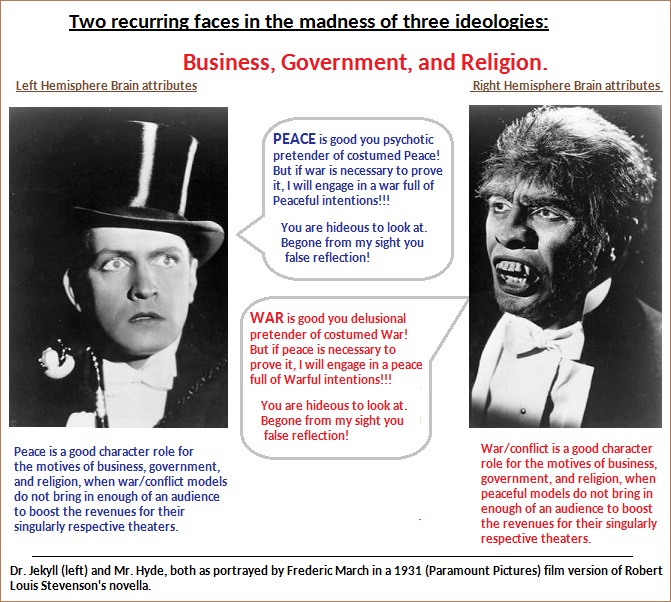
While some readers may not view the right hemisphere attributes of the brain as being monstrous, brutish or ugly, and the left hemisphere attributes as polished, refined and sophisticated, as a generality in order to point out a contrast, the illustrations serve this point if nothing else. The contrasts, as set into the the personality of a single person transformed by an elixir Dr. Jekyll concocted to split the personality into two distinct representations, does not however describe that the "elixir" can be any number of substances that can be consumed by one's body, mind, or "soul". For example, the concept of love is sometimes viewed as an elixir described by poets as that which has the power to move someone to ecstasy, madness, or inspiration. Business, politics and religion are other such elixirs. Yet, the images of the two present us with the occasion of seeing double, an after-image, or distortion like that seen in a carnival fun-house mirror.
For example, if one peers into the following image for a period of time, like the image we typically describe in portraying the concept of peace; its after-image can linger. However, the geometric contour should not mislead one into thinking that only a circular model works, or that the same color scheme need be used. The word "color" is a relative term since there are different "colors" to emotions and mentalities, as well as physical exertion... or the lack thereof.
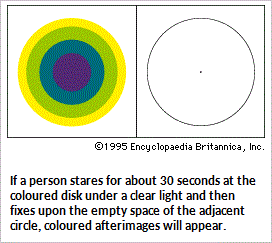 |
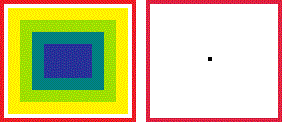
The effects of the after-image can be altered by using different geometric configurations and color schemes... such as the naturally occurring rainbow combination. |
The after-imaging effect is an interesting topic in itself with respect to the origin of biological form, function and behavior when we take into consideration what effects the Sun's (and Moon's) irradiation would have had on the sensitivity of early biological development in an environment in which there may have been a difference in the intensity and duration due to atmospheric differences and the increased rotation rate of the Earth. However, this visualization must be accompanied by the realization made today due to time-elapsed photography set in one place to capture the path of the Sun on its dawn to noon to dusk trek... which reveals a triangular path and not the "across the sky" idea nor the perspective that the Sun treks over the sky as if in an arch. The following first image displays the path of the Sun along its triangular path, though we could substitute it with the Moon. The image next to it illustrates the expansion of the Sun on its trek towards a burnout and how the expansion may engulf the inner-most three planets, though only the Earth is show in this portrayal:
 |
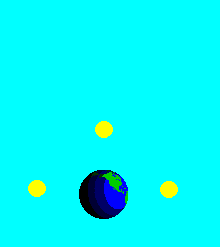 |
The first image displays the after-image of the triangular path that may have been "branded" on the psyche of humanity (and brains, behavior, or instincts of other organisms); thus accounting why the triangular image crops up again and again in such forms as pyramids (stone), pyramids (mounds), pyramid roofs (slanted), Native American Teepees, arrow/spear heads, v-shaped engine blocks, flight formation of migrating birds, etc... If the after-image is mixed with different physiologys, climates, terrains, etc..., this might well account for the diverse forms. Indeed, genetic lines of descent may play a part in altering the after-image configuration.
The second image may well be describing what shall become of three-patterned forms and functionality, including the triplet coding in DNA and RNA. In other words, there is a progressive "fusion" the Sun's three "moments/event" (dawn- noon- dusk). Whereas many three-patterned ideas exhibit a strong dichotomy (such as "Thesis/ Anti-thesis") before expressing a third (such as "Synthesis"), this suggests that early anatomical/biological substrates were more sensitive to the duality of a night/day, hot/cold scenario. The third component thus reflects a representation of a maturational development from which would emerge a shadow, a vague symbol, a fledgling sketch of its presence that would then present an overall three-patterned picture, though it may be but the early expression of a crudely designed finger painted portrait illustrating "stick figures" so to speak as part of its immaturity. The "synthesis" part of the "Thesis, Anti-thesis = Synthesis" three-part model is an emerging property that has not yet matured. The overall structure is a type of mental babbling because the human brain is in its infancy... yet it is an environment that is binding its mental feet and subjecting the skull to pressures that to try to form it into a cone-shaped configuration... figuratively speaking.
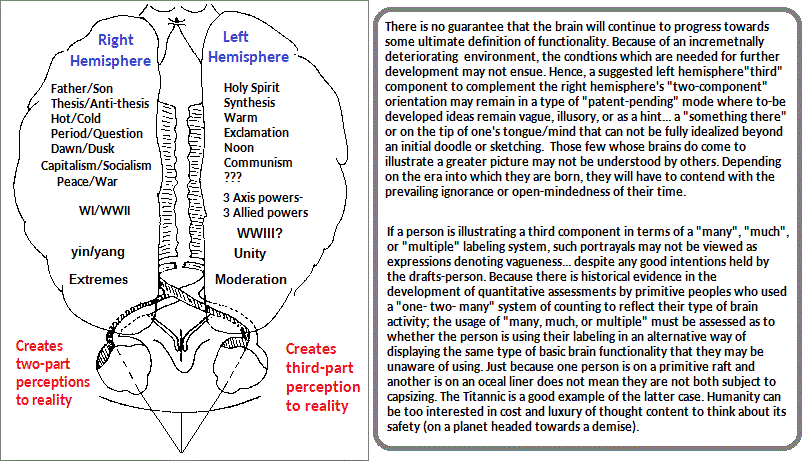
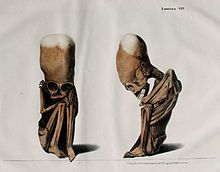  |
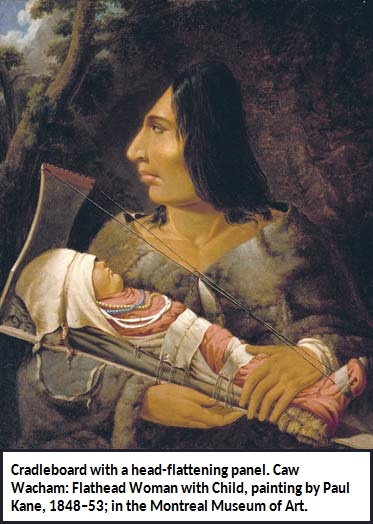 |
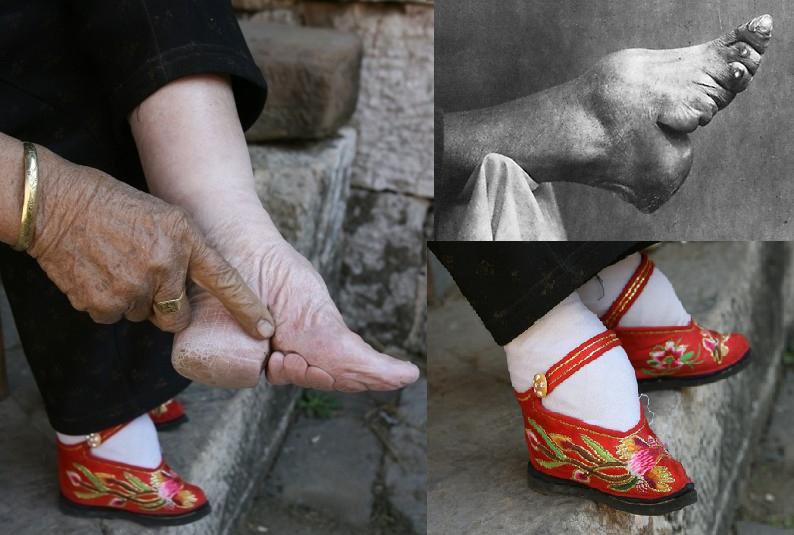 | |
Image sources:
Wikipedia: Artificial Cranial Deformation
The Scarlet Woman: Foot binding
But digressions into the abstract, the imaginative and metaphorical does not sit well with those whose minds are not practiced at seeing the same vista through a different medium of perception as might an artist, poet, musician, architect, or museful cloud watcher. In fact, they define Peace as that which is written in a dictionary. There is no other way for them to organize their thoughts... much like a child in a concrete operational mode of thinking. The following excerpt from the Britannica on concrete thinking is instructive:
In forming hypotheses about the world, adolescent cognition can be seen to grow along with formal, scientific, logical thinking. Consider, for example, a problem of combinatorial thought: An adolescent is presented with five jars, each containing a colourless liquid. Combining the liquids from three particular jars will produce a colour, whereas using the liquid from either of the two remaining jars will not produce a colour. The adolescent is told that a colour can be produced but is not shown which combination produces this effect. Children at the concrete-operational stage typically try to solve this problem by combining liquids two at a time, but after combining all pairs, or possibly trying to mix all five liquids together, their search for the workable combination usually stops. An adolescent at the formal-operational stage, on the other hand, will explore all possible solutions, systematically testing all possible combinations of two and three liquids until a colour is produced. Source: "Human Behaviour." Encyclopædia Britannica Ultimate Reference Suite, 2013. |
The foregoing example is of particular value in that the writer of this page in this series had encountered just an exercise in a psychology lab course many decades ago. The instructor paired up the students and said that we needed to work together to solve the problem of which three vials would produce the result. As a seat was taken next to the other student, the answer was seen by an intuitive apperception but the other student didn't believe it. When she complained to the instructor and it was discovered that the "from out of no where" revelation was indeed the answer, instead of giving this writer the benefit of a doubt; they were accused of having retrieved the answer from another student in another class period. There was no way of getting the instructor nor anyone else in the class to believe that the answer was somehow intuitively perceived. Concrete operational thinkers have difficulty with such articulated appearances of extra-normal perception. No one in the class appeared to grasp the reality of intuitive thinking... even though they may well have read or heard about it occurring with someone noted in a textbook.
For those adults who retain a large measure of concrete-operational thinking in one or more respects; in order to mask the primivity of perception with respect to logical processing, they have the experience which permits them to avoid situations which would exhibit their inability. They want to keep the social atmosphere in a state of functionality which presents them with the similar types of problems which they are practiced at solving, and do not require innovative or novel approaches typically referred to as creative thinking. They want to ensure that a problem is labeled the same and thus will present itself in only those situations which their labeling can apply, and that they are permitted to play an overseer role to "solve" a problem that they know the answer for because a given problem is how they manufactured it by retaining environmental/social circumstances which are favorable to the generation (formative development) of the problem as they can best comprehend it.
By comparing the duality of the Peace/War (conflict) concept with after-imaging and other illusions such as describing the sight of water on the surface of a hot desert sand (or asphalt paving) seen in the distance (from which the notion of Jesus walking on water might well come from); it is of need to point out that illusions can take different forms with respect to the different senses and deflecting mediums which may intercede between a person and a given source of light, sound, temperature, sensation, etc... For example, distortions of sound might be heard as a human voice, or a given taste distorted by its application to a memory, or a given sight due to the type of light being emitted. Alfred Einstein's thinking on refraction was revealed in his Theory of Relativity, though it is dealing with an explanation focused on a concrete expose' related to the fluidity of time and space... meaning they were dynamic configurations existing outside the confines of human static applications such as one's personal time of doing something and one's personal space of existence.
While it may be difficult for some readers to perceive of peace/war (conflict) as an illusion that occupies human attention because it offers a juxtaposed distraction, the analogy is helpful... particularly if some examples of illusions are provided.
It is frequently found that the illusions are provided in a two-patterned drawing of white and black, though a few colorized versions can sometimes be seen. It is also frequently found that the participant is asked to make some two-patterned White/Black or Black/White distinction of geometrically labeled forms such as lines, circles, squares, triangles, etc... It can further be found that on some occasions, the participant is asked to stare, for a period of time, into a white or black portion (such as the middle of a page), in-order that they might perceive some view (such as spots, dots, or circles) in the opposite color than that upon which they are told to stare.
| Two-patterned Optical Illusions Why are there so few three, four, five, etc...-patterned optical illusions? | |
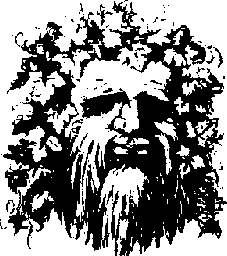 Old man or Kissing couple? |
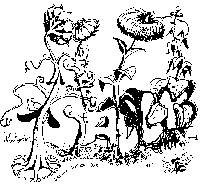 Word or Weeds? |
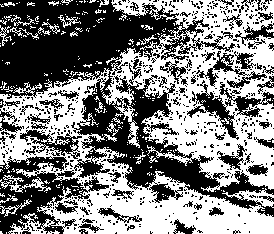 Dog or Speckled shadow? |
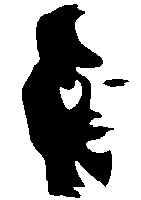 Saxophone player or Lady? |
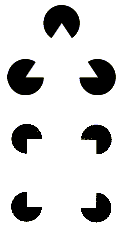 White over Black? |
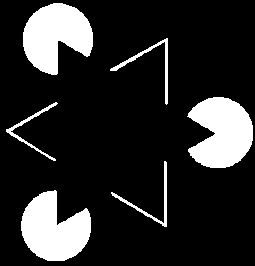 Black over White? |
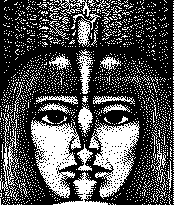
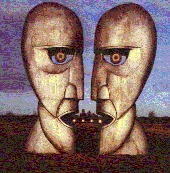 Two faces or One face? |
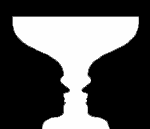 Two faces or a goblet? |
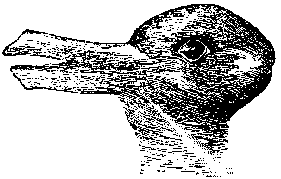 Duck or rabbit? |
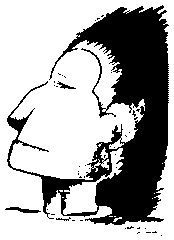 Native American or Eskimo? |
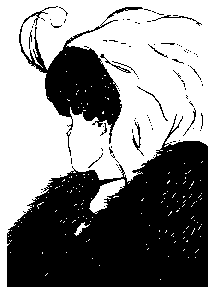 Young or Old woman? |
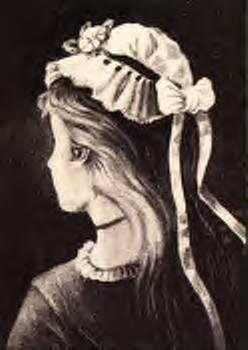 Young or Old woman? |
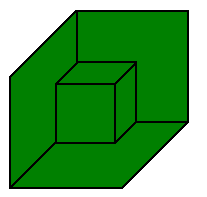 Inside or Outside cube? |
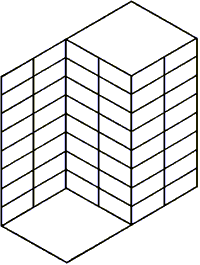 Inside or Outside corner? |
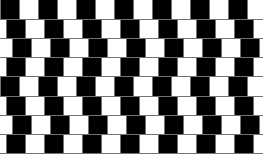 Straight or Crooked Horizontal lines? |
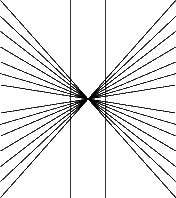 Straight or Crooked Vertical lines? |
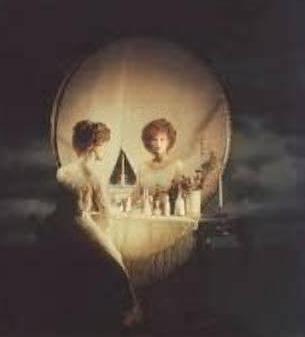 Skull or woman in mirror? |
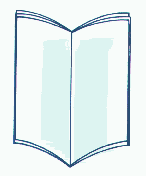 Opened towards or away from you? |
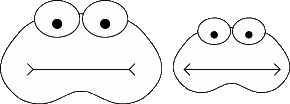 Which (mouth) line is wider? |
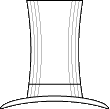 Is the Hat taller or wider? |
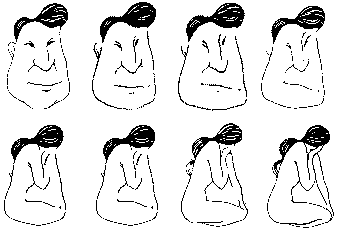 Is this a Man or Woman? |
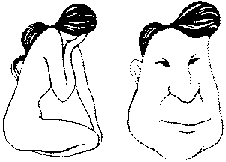 Man or Woman? |
 Canadian Flag or 2 brow-butting people?  (Dots for eyes supplied to help the blind see.) |
 Face on Mars or Mountain range?  Natural or unnatural defacing of nature? |
 Twisted or not twisted triangle? |
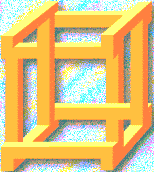 Inside or Outside cross beams? |
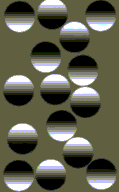 Concave depressions or Convex spheres? |
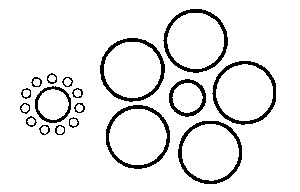 Same size or different center circles? |
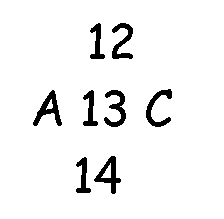 Numbers or Letters? |
 Is the phrase correct or not? |
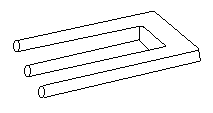 Two or Three prongs? |
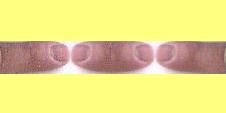 Two or Three fingers? (Place tips of two fingers together and a visual trick of the eyes may produce a single finger with two tips.) |
Another type of two-patterned (projective) test is the Thematic Apperception Test (TAT) which consists of 30 black and white cards (from which 20 are typically selected) consisting of drawings, paintings and photographs depicting a variety of solitary and interpersonal situations, and is sometimes used to describe personality or aspects of emotional disturbance. Those who participate in such a test are sometimes asked to give a three-patterned Beginning- Middle- End narration. (I can recall that as a young child, students would sit in a circle and were asked by a kindergarten teacher to tell a story about characters in a book. The good story tellers (those who narrated a story with three parts) would receive the most praise.)
It should be noted that such tests can interpreted very subjectively by the test interviewer. I is a circumstance that leads some to view such subjective-laden tests as being similar to a person's verbal, facial and body expressions being used as clues for the interpretations made by palm readers, fortune tellers and those claiming to be able to contact dead people... as well as those who have their hands in the various astrology and tarot card readings. However, this does not diminish the fact that some people are quite adept at reading subtleties of behavior that do provide clues to a person's "hidden" personality, problems, and persistent characteristics that another might colloquially referred to as a "hangup", negative compulsion, or "oppositional force" which brings them to the attention of an analyst.
Now let's a look at some more examples of illusions that exhibit an after-image effect by staring at them and then looking at the different colored spaces next to it. One may notice that in order to reach the colors beyond white, a longer period of staring time is required to achieve a "centered" hovering of the colors beyond white... but this doesn't mean more subtle after-images don't effect one's sub-conscious, since the after-image may linger on a cellular level than what is customarily being identified without the usage of a more sensitive detection means. While most people engage in a stare-at-one-image-at-a-time activity, this does not mean that someone with an active visual peripheral inclination does not have overlapping image effects. (Even though this series of essays on Peace do discuss other forms of peripheral activity (mental, emotional, social, intellectual, analytical, biological, academic, etc., such an application of the word "peripheral" is not customarily known, acknowledge or for that matter discussed, because for many it would be too metaphysical, too imaginary... even though to someone of the 16th Century (and other periods), trying to talk about television ("pictures over the air"), radio ("long distance voices") and many other present day common topics; might seem to them as crazy or witchcraft talk.
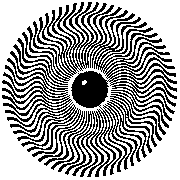 Moving or Non-moving fan? |
|||
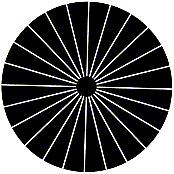 Moving or Non-moving spokes? |
|||
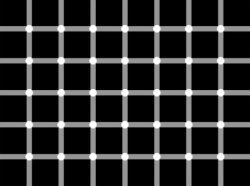 Blinking or non-blinking dots? |
|||
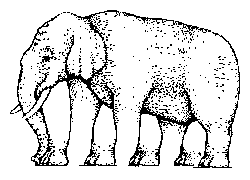 Four or more legs? |
|||
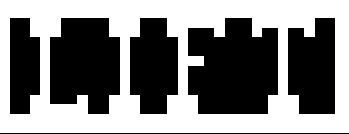 Do you see the word "lift"? |
|||
 Shrinking or enlarging dot/area? |
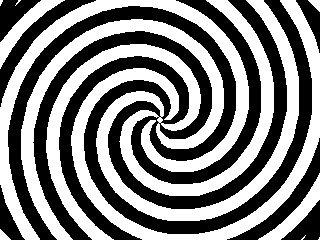 |
Stare at the center of the image for twenty seconds and then look at the white space or even the palm of your hand. Is there a spiral or isn't there? |
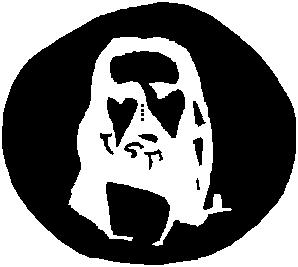 |
Stare at the blue dots while you count slowly to 30. Then close your eyes to see a circle of light slowly appearing. Try this again and look at the white space below (or some other white surface such as a wall, table, etc.). |
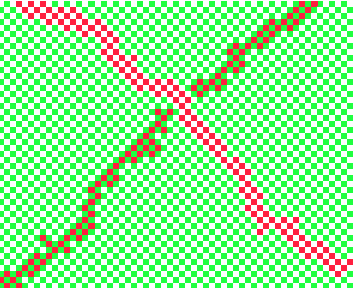 |
How many shades of green do you or don't you see? |
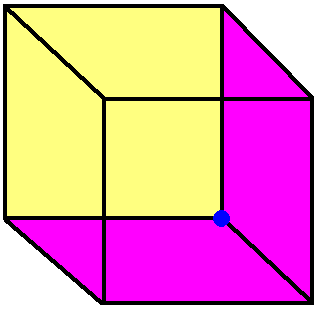 |
Is the blue dot at the nearest or furthest corner (Inside or outside)? |
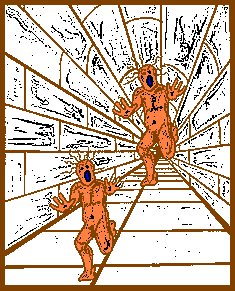 |
Are these two figures the same size? |
 |
Start at the red dot and try to follow the spiral to the center. |
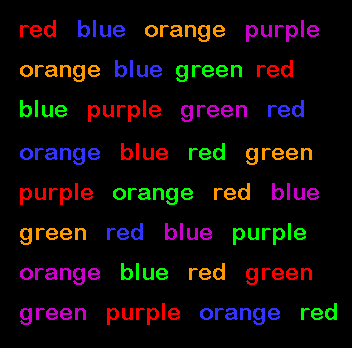 |
Say each color of ink (and not the color word) out-loud as fast as you can. Do you slow down or go faster by saying the color word or the word color? |
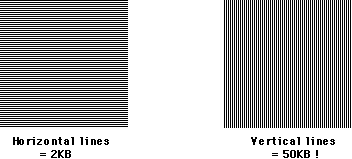 |
Do the lines shimmer? Are there diagonal or circular lines seen in the middle white area after staring at either (both?) of the lined squares. |
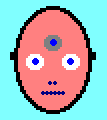 A 3rd eye? |
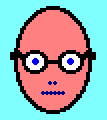 2 or 4 eyes? |
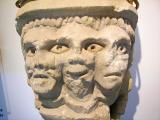 4 or 6 eyes? |
 5 or 8 eyes? |
And yes, let us remind the reader that what is being discussed is the phenomena of Peace set into the framework of a dichotomy illustrated as a contrast.
Date of Origination: Saturday, 24-Dec-2016... 02:00 AM
Date of initial posting: Tuesday, 27-Dec-2016... 12:00 AM
Updated posting: Fridday, 5th October 2018... 2:17 PM